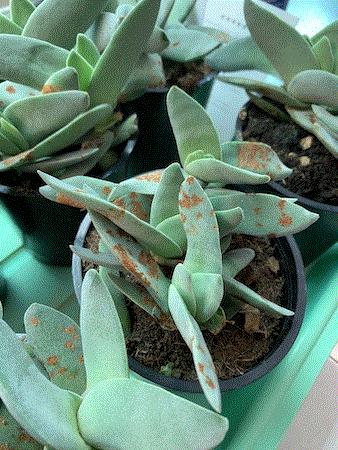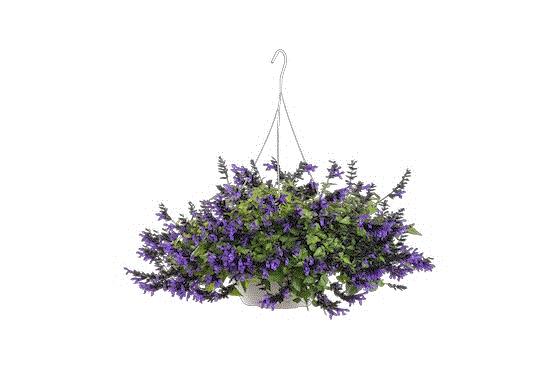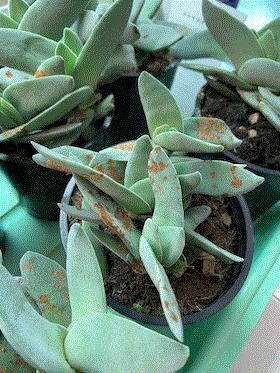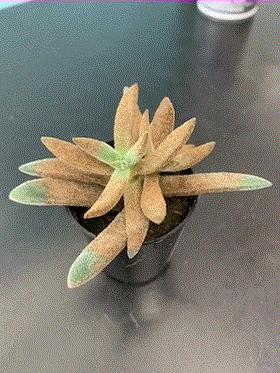What’s Happening Here?
I was recently talking with an industry professional who I can’t name without significantly narrowing down the possibilities for this upcoming challenge. During the conversation, I twisted her arm to share an interesting challenge I could use in the newsletter and she didn’t disappoint. Take a look at this succulent:

No, this isn’t a new leopard crassula. This plant has a problem and I challenge you to determine it’s cause. What about clues? Like most challenges, I’m not going to give you much to go on besides this image. I can say that I’ve covered this problem more than once in previous newsletters, but with 170-plus newsletters over the past seven-plus years I’ve been sending these out, I doubt that’s very helpful.
Remember, this could be caused by a number of things, such as an abiotic disorder, a nutritional problem, insect, disease or a number of other possibilities. Again, this probably isn’t very helpful. The time has come for me to ask, “What’s happening here?” Ponder the possibilities as you read the newsletter and I’ll let you know what’s happening to this succulent in a few minutes.

Plant Disease Resistance

Are you having difficulty with the terminology used to described plant disease resistance? It’s easy to get confused when terms like "resistance," "immunity," "tolerance" and "susceptibility" are commonly used seemingly interchangeably. Rather than attempting to explain these terms and the sometimes subtle differences myself, I’d like to refer you to a hot-off-the-press article published in the e-Gro Alert (Vol 10 Number 16 March 2021). This article not only provides industry-accepted terminology, but also helps provide an understanding of what these terms mean when it comes to managing diseases.
I encourage you to not be resistant to this information ... the health of your crops may depend on it. Click HERE to read “Plant Disease Resistance, Reviewed.”
California Trials Preview
I’m looking forward to the California Trials in June—Wednesday, June 23 to Sunday, June 27, 2021 to be exact. I’ll provide more details on the trials in the next newsletter, but for now I thought I’d share a brief sneak peek at a couple of new perennials from PlantHaven that’ll likely be making their California Trials debut.
Salvia Bodacious Hummingbird Falls
Check out the world’s first hanging basket salvia.

As you can see, this Salvia x guaranitica cultivar is a beautiful plant and not only makes an excellent hanging basket, but will also have a place in the front of perennial borders. Hummingbird Falls has attractive, compact 4-in. flower stems that are ideal for attracting hummingbirds into outdoor living spaces. It’s hardy to USDA Hardiness Zone 7. The first cuttings of Salvia Bodacious Hummingbird Falls will be available from Dümmen Orange this fall. I’m excited to see a salvia that not only has its place in the landscape, but always performs well in containers and hanging baskets.
Hedera Tropical Blizzard
Here’s a great variegated Algerian Ivy (Hedera canariensis) that can be used as a houseplant, in mixed containers or as a groundcover in warmer climates. With cold hardiness to Zone 8, this isn't a hardy ivy, but is worthy of your consideration for other product lines. Tropical Blizzard has unique, highly variegated leaves with gold to pure white marbling and flecking with shades of green in between. As an added bonus, you’ll likely appreciate its bright, pink-red stems.

Tech on Demand Newsletter
Although Senior/Digital Editor Bill Calkins is no stranger, I’d like to welcome Bill back to the newsletter world. Earlier this month, Ball Publishing lunched a new newsletter called Tech on Demand where Bill is taking the lead role. Tech on Demand is a spin-off of the popular podcasts, webinars and Facebook group of the same name that Bill has been providing to our industry recently.

Each week, Bill aims to provide useful and relevant technical and cultural information in the newsletter. Here are a few of the topics that were in the first two weekly issues:
-
Chase on Fusarium: What can you do?
-
Executing the PourThru Method
-
"Release the Beasts"—a Predatory Mites Tale
-
Watering Wisdom via Print, Video, Slideshows
-
Waking Up Perennials
This is just a sampling of the great topics Bill’s shared in Tech on Demand so far. If this seems like something you’d enjoy and benefit from, I invite you to preview last week’s issue (Tech on Demand–March 19, 2021). And if this is something you’d like to receive every week, you can sign up for it by clicking HERE.

Tech on Demand Podcast
I mentioned Tech on Demand was a spinoff, didn’t I? The original Tech on Demand was in the form of informative podcasts. If you like the new Tech on Demand newsletter, I encourage you to check out the great podcast episodes you can enjoy and benefit from for FREE!

Here’s what Bill covered in his most recent episode.
Tech On Demand: Level Up Your Value Proposition
In this episode, host Bill Calkins has a great discussion with industry veteran, Bryce Anderson, sales manager for The HC companies. Bryce has a wide range of experiences, ranging from grower to production manager to garden center manager to sales and operation management that makes this discussion interesting. The core theme is “Product Differentiation is Critical to Your Value Proposition” with Bill and Bryce discussing many topics, including:
-
Ways and reasons to differentiate
-
Importance of product uniqueness
-
Finding products that are truly different
-
Costs to differentiate and the costs not to differentiate
-
Creative ways to elevate a product mix
-
Grabbing the attention as a wholesale grower
The great thing about podcasts is you can listen to them virtually anywhere and on your own schedule. Here’s a direct link to this episode: techondemand.podbean.com/e/level-up-your-value-proposition.
If you like it, or would like to peruse the previous topics, you can check them out at growertalks.com/TechOnDemand. You can also subscribe to Tech On Demand on all major podcast apps like iTunes, Google, Spotify, Stitcher and more so you never miss an episode.

The Answer is …
At the top of the newsletter, I challenged you to determine the cause of the problem on this crassula. Take another look at the image I’ve already shown on the left as well as a more severe case of this on the right:
|

Tom Cresswell
|

|
If you’re still uncertain, perhaps the biggest clue I can give you is these images were submitted by Dr. Janna Beckerman, Professor and Extension Plant Pathologist at Purdue University. I’d say that should narrow down the field of possibilities. What else is there? Oh, how about this pathogen looks totally different on other types of plants than it does on succulents? You nailed it—it’s powdery mildew. Dr. Beckerman confirmed this diagnosis with PCR.
As with most pathogens, powdery mildew is best managed preventively. When possible, manage the relative humidity (<70%), particularly at night, provide lots of air circulation and grow susceptible crops at wider spacings. There are several biosolutions and traditional chemistries available for controlling powdery mildew. Some of my favorites include extract of neem oil, potassium bicarbonate, myclobutanil, piperalin and triflumizole.
Be on the lookout later this year for a great new fungicide from OHP, Inc. that specializes in powdery mildew. It’s called Seido and contains pyriofenone that belongs to a new mode of action group 50 and has a really cool vapor phase, which aides in protecting crops from powdery mildew infections.
Before signing off for the week, I’d like to thank Dr. Beckerman for submitting this week’s challenge and give a shout out to the Purdue Plant and Pest Diagnostic Lab. I’ve personally used them in the past and find them to be reliable with acceptable turnaround times and reasonable pricing. If you’re looking for a great diagnostic clinic, I’d give them a try. Click HERE to learn more about the Purdue Plant and Pest Diagnostic Lab.




Thanks for reading this edition of Perennial Pulse. My email is ppilon@ballpublishing.com if you have any comments or suggestions.
Take care,
Paul Pilon
Editor-at-Large - Perennial Pulse
Technical Manager - OHP, Inc.
This email was received by you and 30,914 other fine subscribers!
If you're interested in advertising in Perennial Pulse, contact Kim Brown ASAP and she'll hook you up.